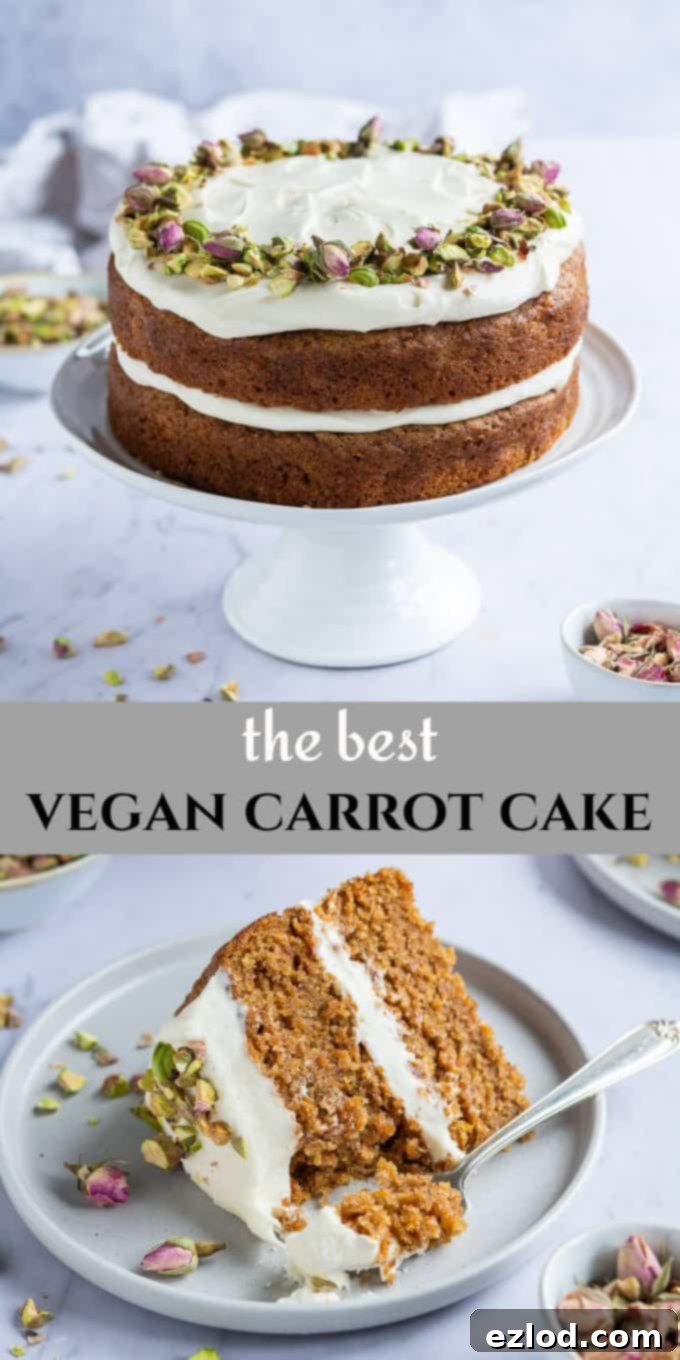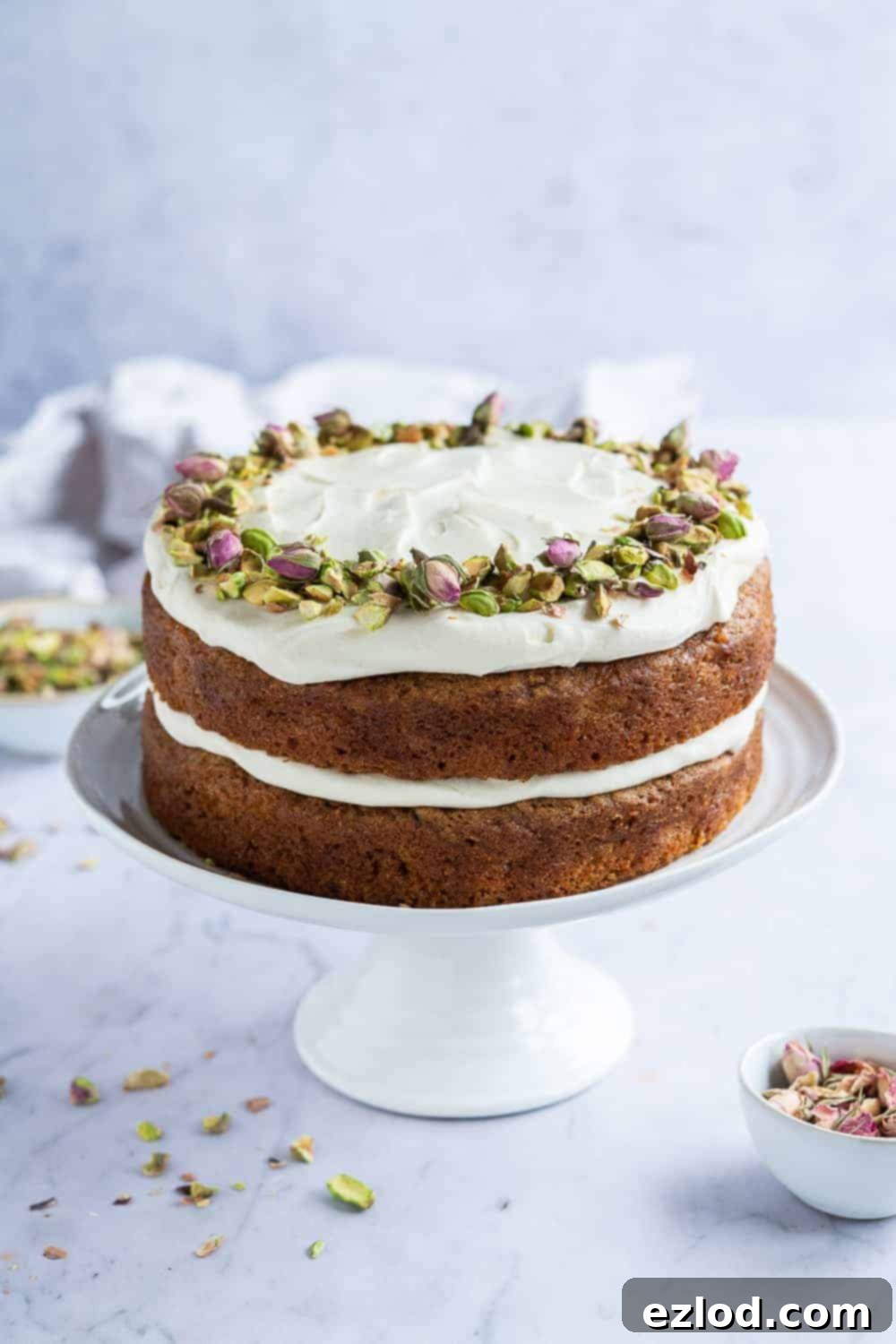The Ultimate Moist Vegan Carrot Cake with Cream Cheese Frosting (Dairy-Free & Eggless!)
Discover the magic of this classic vegan carrot cake recipe – a truly exceptional, eggless, and dairy-free rendition of the beloved carrot layer cake. It’s generously filled and topped with a luxurious, creamy vegan cream cheese frosting that’s so good, you won’t believe it’s vegan! Perfect for special occasions like Easter, Mother’s Day, birthdays, or simply as a delightful treat for any celebration. Prepare to impress everyone with its incredible flavor and texture!
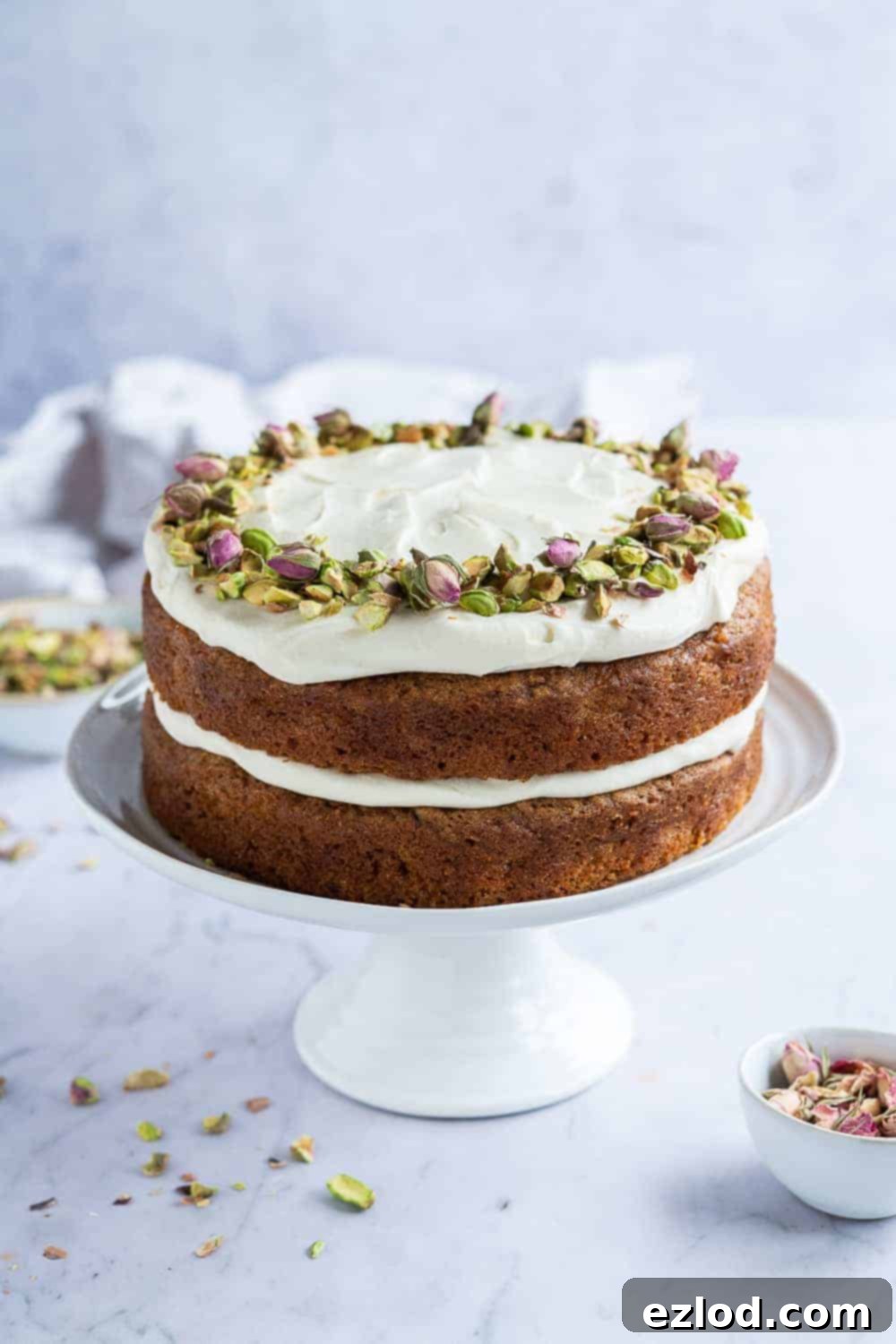
This exquisite vegan carrot layer cake, complete with its rich and tangy cream cheese frosting, stands as the pinnacle of plant-based baking. It’s not just a cake; it’s an experience, offering all the traditional comforting flavors without any animal products. Each bite delivers a harmonious blend of sweetness and spice, making it an instant favorite.
Crafted with two tender, remarkably moist, and perfectly spiced carrot cake layers, this dessert is a true masterpiece. These layers are lovingly brought together and crowned with a generous swirl of creamy vegan cream cheese frosting. The result is a celebration-worthy cake, ideal for festive gatherings like Easter brunch, Mother’s Day tea, or any special moment demanding an unforgettable dessert. Its vibrant flavor profile and luxurious texture will captivate even the most discerning palates.
For an added touch of elegance, this beautiful cake is typically adorned with a delicate scattering of chopped pistachios and a few dried rosebuds. These garnishes not only provide a delightful textural contrast but also transform the cake into a stunning centrepiece that’s almost too pretty to eat – almost!
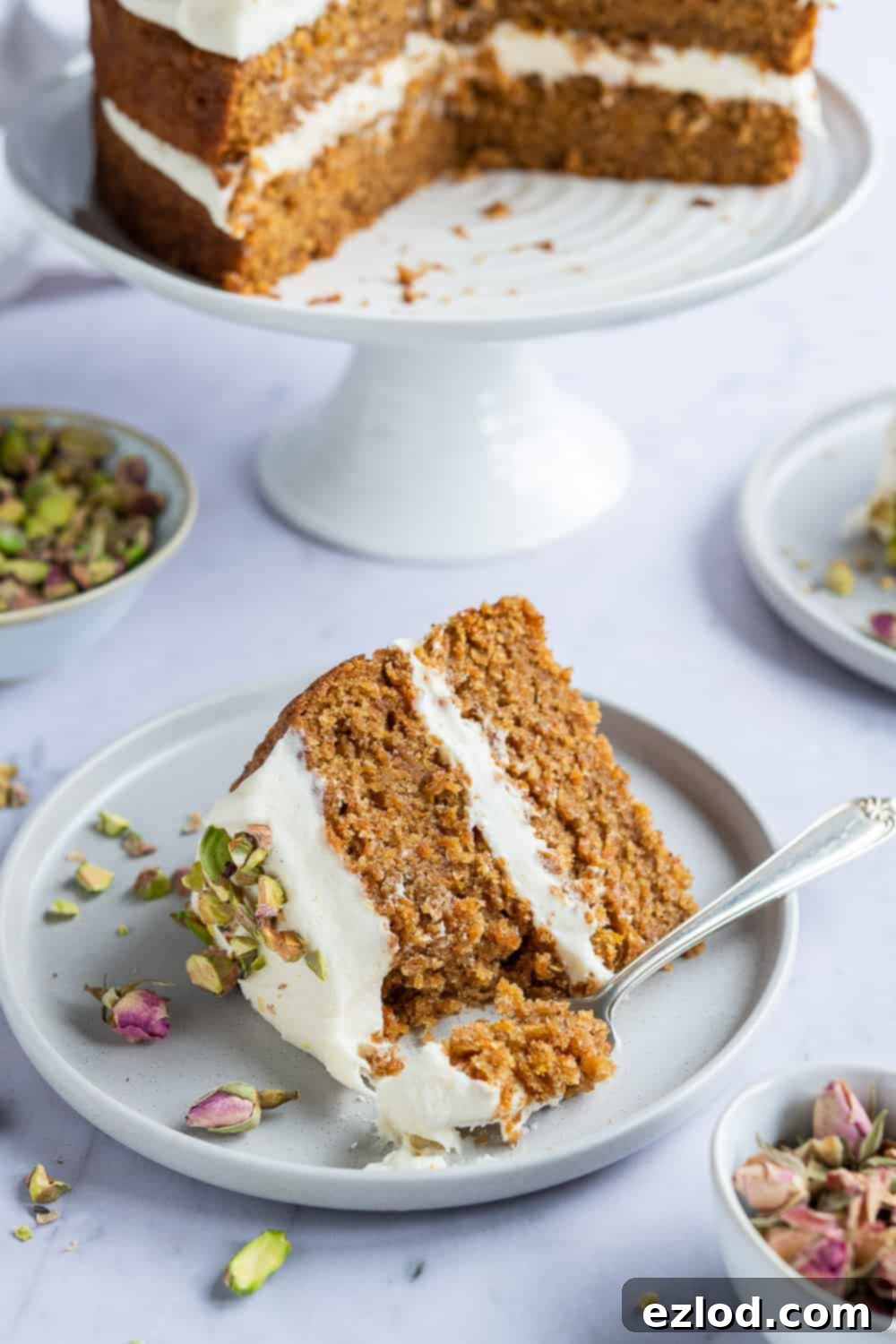
Crafting Your Vegan Carrot Cake: A Step-by-Step Guide
Creating this magnificent vegan carrot cake is a rewarding process. Below, we’ll walk you through each step, ensuring you achieve a perfect result every time. For precise ingredient quantities and detailed instructions, please refer to the comprehensive recipe card located further down this page.
Preparing the Cake Batter
Begin your baking journey by combining the wet ingredients in a spacious mixing bowl. This crucial first step involves thoroughly whisking together caster sugar, light brown soft sugar, sunflower oil, your chosen non-dairy milk (soy milk is a popular choice for its neutral flavor), fresh lemon juice, pure vanilla extract, and fragrant orange or lemon zest. The lemon juice in combination with the baking soda will act as a leavening agent, contributing to the cake’s light and airy texture. Ensure the sugars are well dissolved and everything is beautifully emulsified before proceeding.
Next, it’s time to incorporate the dry ingredients. Carefully add the plain flour, wholesome wholemeal flour, aromatic ground cinnamon, warm ground ginger, fragrant ground nutmeg, bicarbonate of soda (baking soda), baking powder, and a pinch of salt to the wet mixture. These dry components are essential for the cake’s structure, flavor, and rise. Sifting them beforehand can help prevent lumps and ensure even distribution.
Gently whisk the wet and dry ingredients together until just combined. The key here is not to over-beat the batter. Excessive mixing can overdevelop the gluten in the flour, leading to a tough, dense cake. Stop whisking as soon as no pockets of dry flour remain – a few small lumps are perfectly acceptable and won’t affect the final outcome.
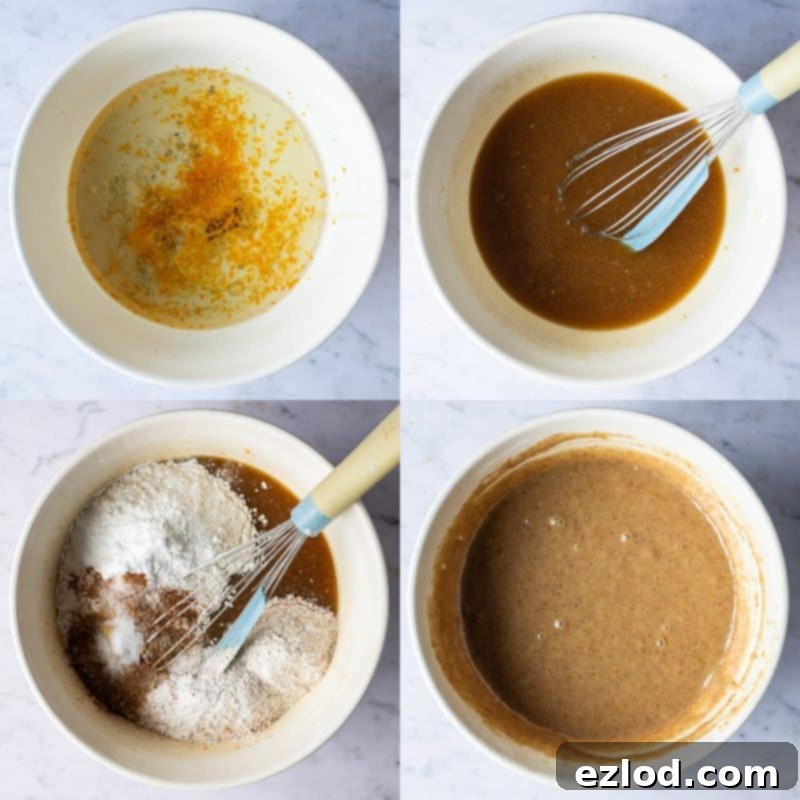
Finally, introduce the star ingredient: freshly grated carrots. These provide not only the signature flavor and color but also contribute significantly to the cake’s moisture. If you prefer, now is also the perfect moment to fold in any desired mix-ins, such as crunchy chopped walnuts, pecans, or sweet raisins. Gently fold these additions into the batter until they are evenly distributed, ensuring a delightful surprise in every slice.
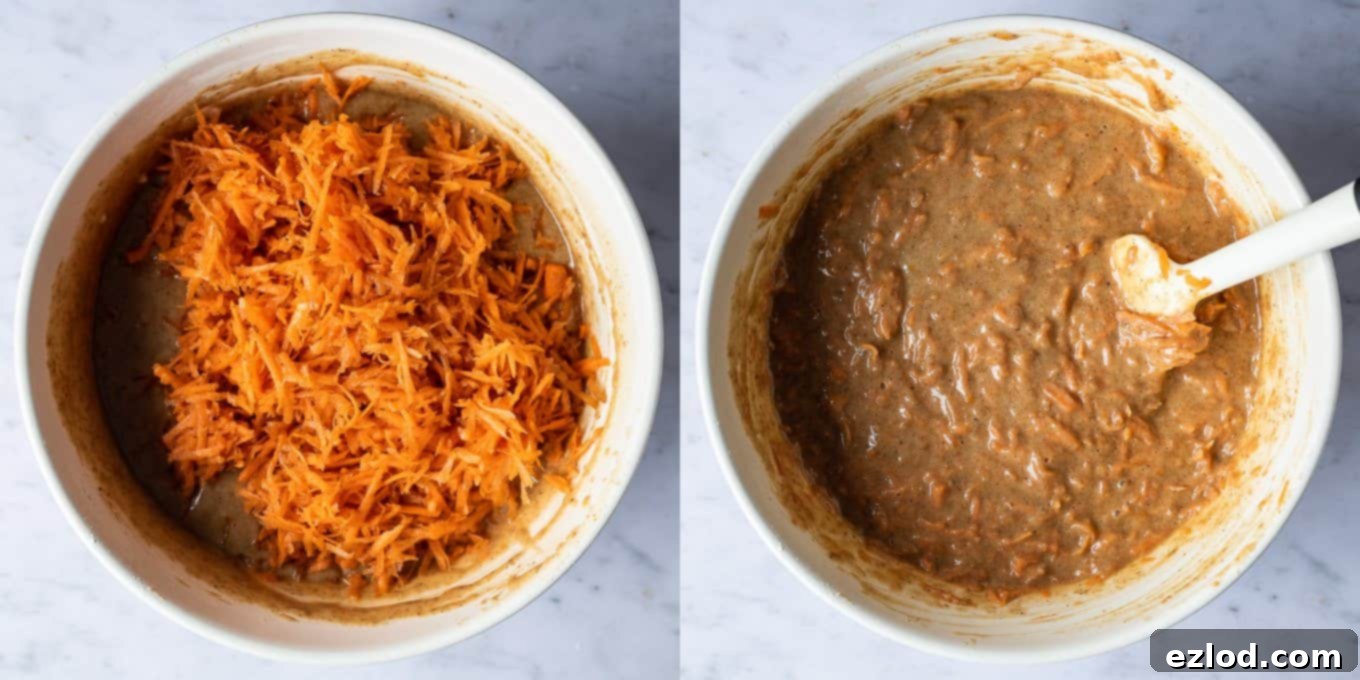
Baking the Perfect Layers
Once your batter is ready, divide it evenly between two greased and lined 8-inch round cake tins. Using a kitchen scale can help ensure precise division, leading to perfectly even cake layers. Gently spread the batter level in each tin. Bake for approximately 35 minutes, or until a wooden skewer inserted into the center of the cakes comes out clean. This indicates they are thoroughly cooked. The tempting aroma filling your kitchen will be a good sign!
After baking, resist the urge to immediately remove the cakes from their tins. Allow them to cool in their tins for about ten minutes. This crucial resting period helps the delicate cakes firm up, making them less prone to breaking. Once rested, very carefully invert them onto a wire rack to cool completely. Patience is key here; warm cakes are very delicate and can crumble easily. Ensure they are entirely cool before you even think about frosting them, as a warm cake will melt your beautiful frosting.
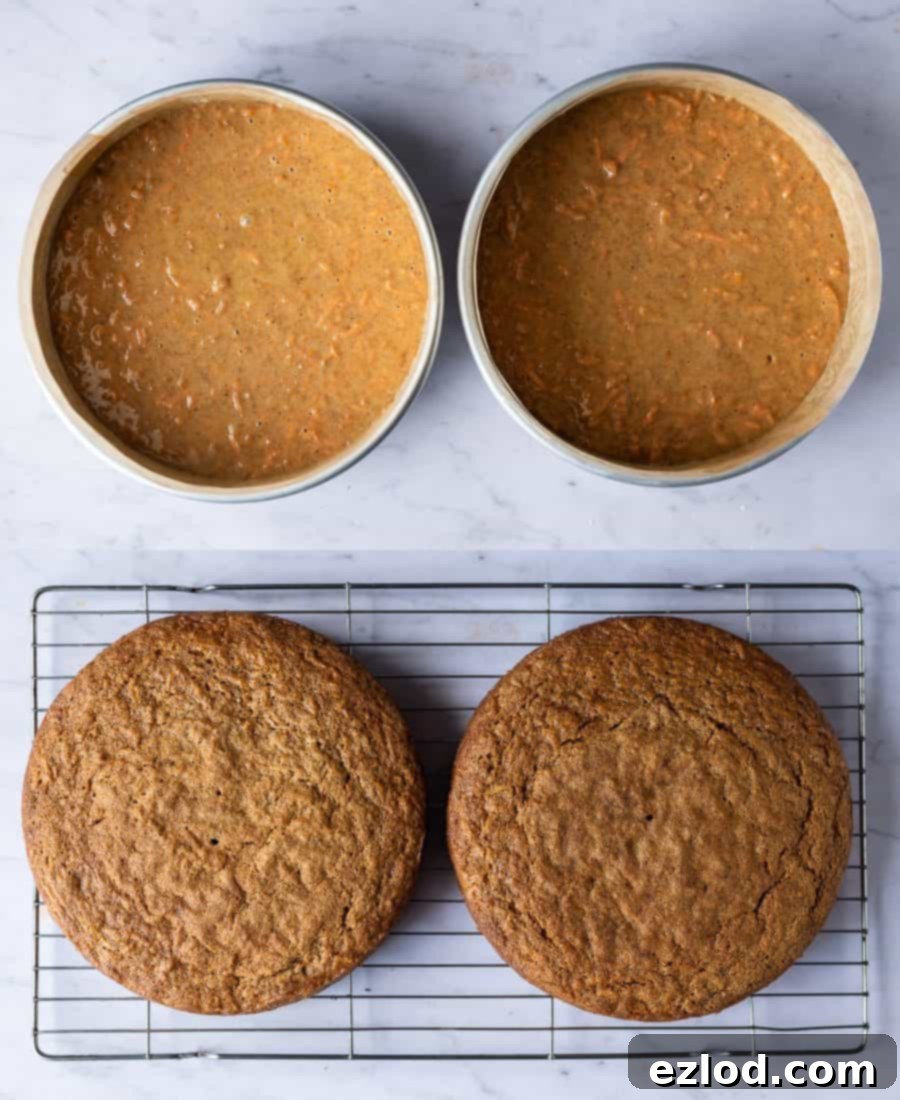
Whipping Up the Creamy Vegan Cream Cheese Frosting
The frosting is where the magic truly happens for any carrot cake. To make this luscious vegan cream cheese frosting, start by placing softened, room temperature vegan block butter into a large mixing bowl. It’s essential to use block butter, not the spreadable kind, as block butter has a higher fat content and better structure for frosting. Next, carefully drain any excess liquid from your room temperature vegan cream cheese. Gently pat it dry with paper towels to remove any remaining moisture, which is vital for preventing a runny frosting. Add the prepared vegan cream cheese to the bowl with the butter.
Using an electric mixer, whisk the vegan butter and cream cheese together until they are perfectly smooth and well combined. This initial step creates a stable base for your frosting. Gradually add the sifted icing sugar (also known as powdered sugar) to the mixture. Sifting prevents lumps and ensures a silky-smooth finish. At this stage, incorporate a small but mighty ingredient: xanthan gum. Continue whisking until the frosting achieves a wonderfully smooth, creamy, and spreadable consistency. If you find your frosting is a little too soft after mixing, don’t despair! Simply pop it into the fridge for about 20 minutes to firm up slightly before you begin frosting your beautifully cooled cake layers.
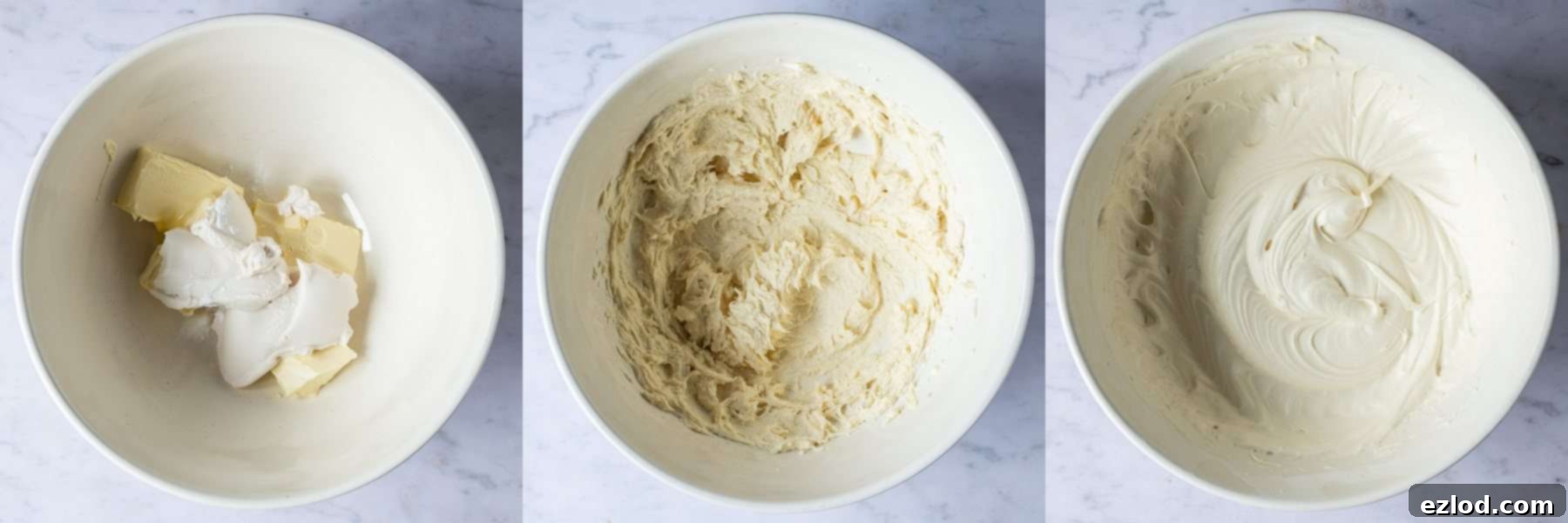
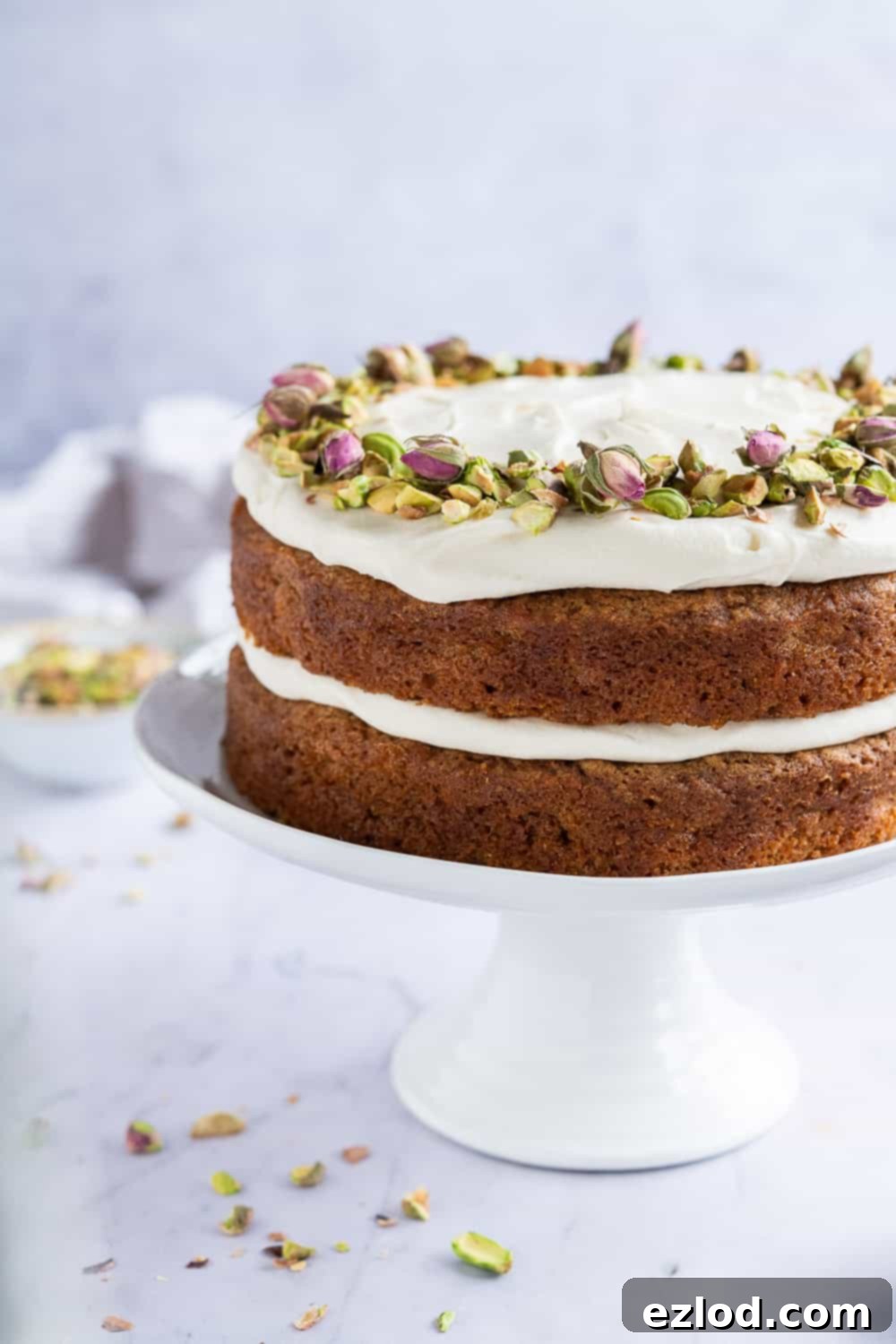
The Secret to Perfect Vegan Cream Cheese Frosting: Xanthan Gum
One of the most common challenges in vegan baking, particularly with frostings, is achieving the right consistency. Vegan cream cheese frosting, in particular, can be quite temperamental. It has a notorious tendency to split, become runny, or lack the stability of its dairy counterpart. Traditionally, bakers might resort to using vegetable shortening instead of butter/margarine, or add an excessive amount of icing sugar to try and combat these issues, often compromising on flavor and texture.
However, I’ve discovered a game-changing secret weapon that eliminates these woes: xanthan gum. This incredible ingredient is a highly effective thickening agent and stabilizer, widely used in gluten-free baking to improve dough structure and prevent ingredients from separating. Crucially, xanthan gum is entirely vegan-friendly and can be easily found in the baking aisle of most major supermarkets or health food stores.
By adding just a small amount of xanthan gum to your vegan cream cheese frosting, you introduce a powerful binding agent. This prevents the oil and cream cheese from separating, creating a stable emulsion that results in a lusciously smooth, incredibly creamy, and perfectly pipeable frosting. It ensures your frosting holds its shape beautifully and provides that delightful mouthfeel without the need for excessive sugar or alternative fats. This tiny addition makes all the difference, elevating your vegan carrot cake to professional bakery standards.
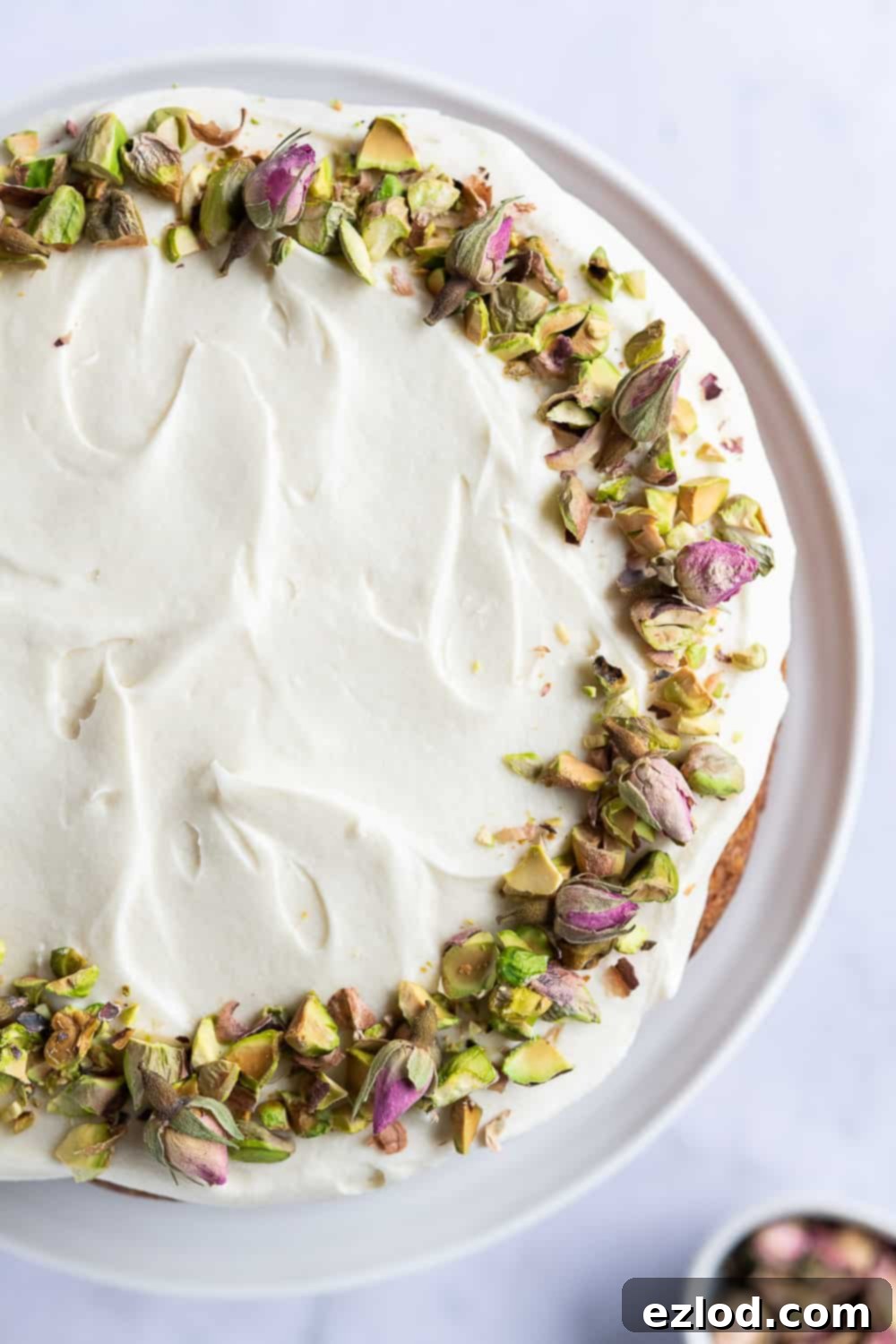
Essential Tips for Vegan Carrot Cake Success
To ensure your vegan carrot cake turns out absolutely perfect, keep these expert tips in mind:
1. **Precision in Measurement:** For the most reliable and delicious results, meticulously follow the recipe. I cannot stress enough the importance of using gram measurements with a digital scale rather than cup conversions. Cup measurements, especially for dry ingredients, can vary significantly depending on how ingredients are packed, leading to inconsistencies in your bake. Grams provide the accuracy baking demands, guaranteeing the best possible texture and flavor.
2. **Carrot Grate Size:** Opt for a standard-sized grater for your carrots instead of a fine one. A coarser grate yields a more distinct carrot texture within the cake, adding a pleasant chewiness and visible flecks that enhance its rustic charm, rather than disappearing into the batter.
3. **Choosing Your Oil:** Sunflower oil is my preferred choice for baking due to its wonderfully neutral flavor that won’t interfere with the delicate spices of the carrot cake. However, you can certainly substitute it with another mild-flavored oil. If you’re open to a subtle flavor influence, olive oil or melted coconut oil can also work. Should you choose melted coconut oil, ensure your non-dairy milk and other wet ingredients are at room temperature. Cold liquids can cause coconut oil to resolidify, leading to uneven mixing and potentially a lumpy batter.
4. **Optional Mix-ins:** Feel free to customize your cake! Along with the grated carrots, you can fold in a couple of handfuls of sweet raisins or crunchy chopped walnuts (or pecans) into the batter. These additions bring extra flavor, texture, and a delightful surprise in every bite.
5. **Cooling is Crucial:** This tip cannot be overstated: allow your cake layers to cool completely before you even think about frosting them or slicing into them. Attempting to frost a warm cake will result in a melted, messy frosting disaster. Patience here guarantees a clean, beautifully frosted cake.
6. **Room Temperature Frosting Ingredients:** When preparing your cream cheese frosting, it is absolutely vital that both the vegan block butter and the vegan cream cheese are at a soft, room temperature. Cold ingredients are far more prone to separating or splitting when mixed, resulting in a curdled or grainy frosting. Room temperature ingredients emulsify beautifully, giving you that smooth, creamy, and stable frosting you desire.
Storing Your Delicious Vegan Carrot Cake: Best Practices
Proper storage is key to maintaining the freshness and deliciousness of your vegan carrot cake.
Once your cake has been lovingly frosted, it’s best stored in the refrigerator. This is because the vegan cream cheese frosting, especially in warmer room temperatures, can become a little soft and lose its structure. While it’s certainly delightful to eat the cake on the day it’s assembled, any leftovers will remain perfectly delicious for 2-3 days when kept in an airtight container in the fridge. For optimal flavor and texture, allow refrigerated slices to come to room temperature for about 15-30 minutes before serving.
If you’re planning ahead, the unfrosted cake layers can be baked a day or two before you intend to make the frosting and assemble the cake. Store these cooled, unfrosted layers in an airtight container at room temperature to keep them fresh and moist.
For longer storage, the un-iced cake layers freeze exceptionally well. Once completely cooled, wrap each layer tightly in plastic wrap, then an additional layer of aluminum foil, and place them in a freezer-safe bag or container. They can be stored in the freezer for up to three months. When you’re ready to use them, thaw overnight in the refrigerator, then bring to room temperature before frosting. I generally do not recommend freezing the prepared frosting itself, as the texture can often be negatively affected upon thawing, potentially becoming grainy or separating.
The frosting is always best made fresh on the day you plan to assemble and serve the cake, ensuring its optimal creamy texture and stability.
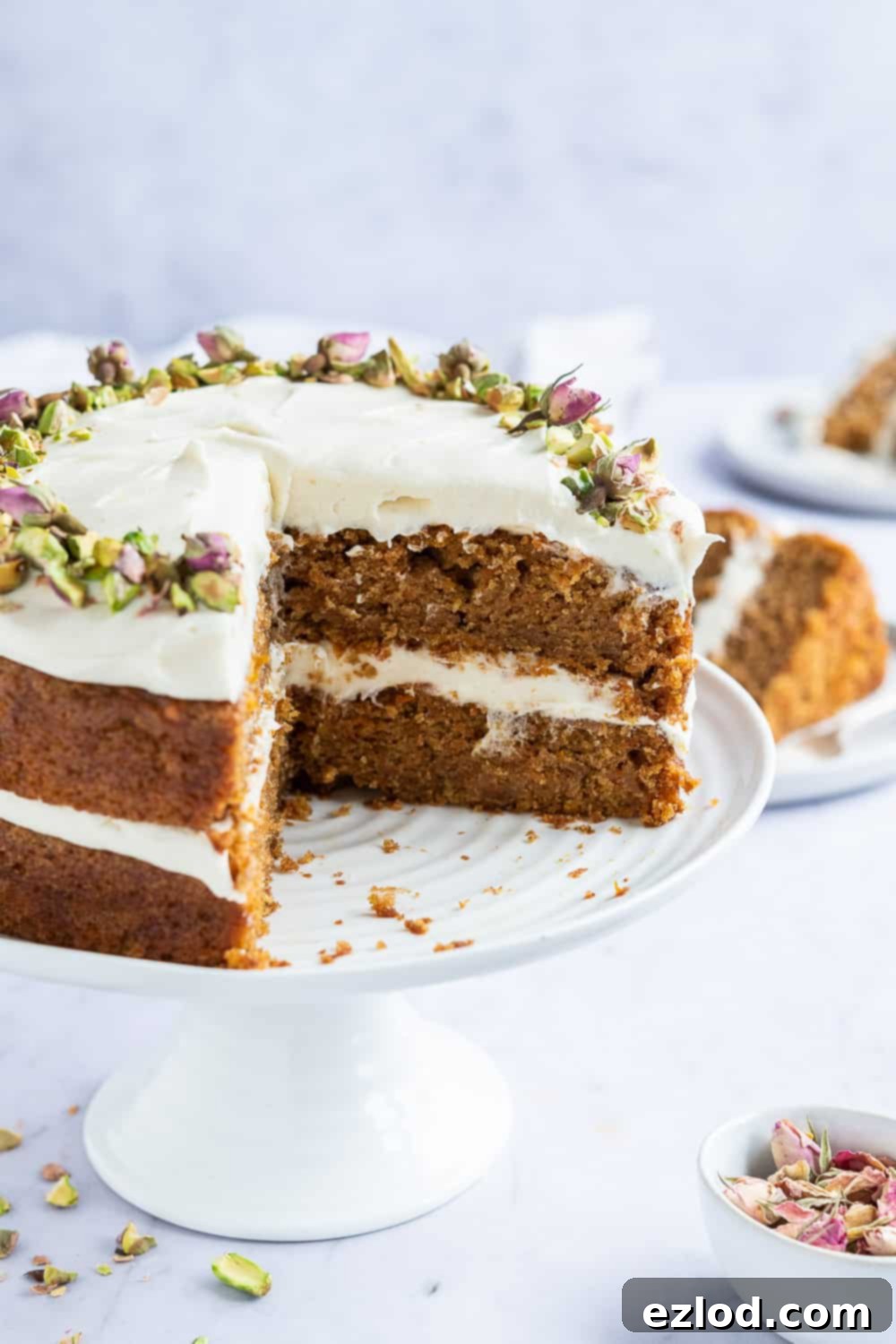
Explore More Classic Vegan Cake Recipes:
If you loved this vegan carrot cake, be sure to check out these other fantastic plant-based dessert recipes:
Vegan Victoria Sponge Cake
Vegan Chocolate Fudge Cake
Vegan Lemon Drizzle Cake
Vegan Ginger Cake
Vegan Fruit Cake
Vegan Coffee and Walnut Cake
Vegan Banana Cake
Vegan Apple Cake
Vegan Coconut Cake
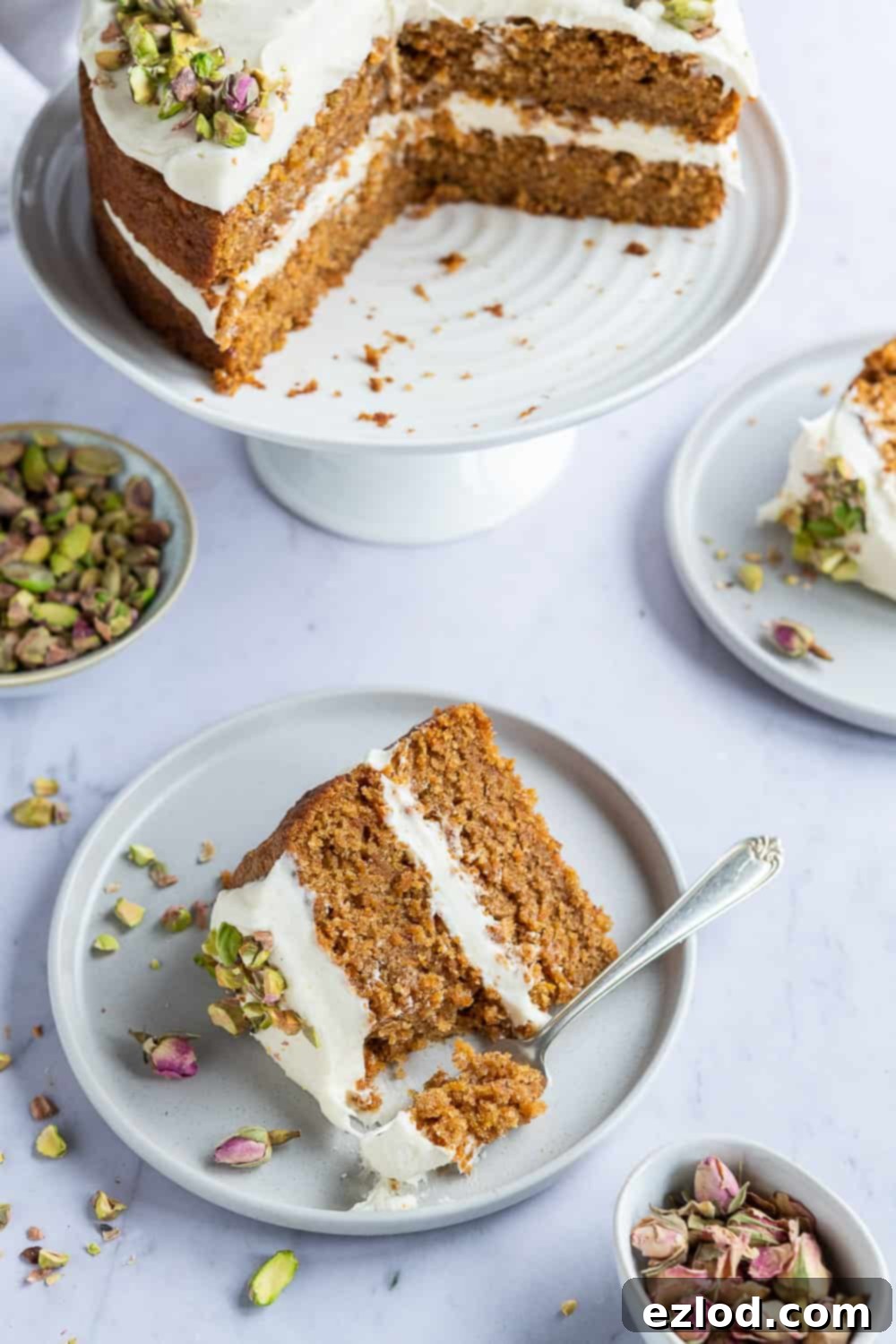
If you tried this incredible vegan carrot cake recipe, we’d love to see your creations! Why not tag @domestic_gothess on Instagram and use the hashtag #domesticgothess to share your baking success with our community?
*All images and content on Domestic Gothess are copyright protected. If you wish to share this recipe, please do so by utilizing the provided share buttons. Please refrain from screenshotting, or posting the recipe or its content in full on other platforms.*

Print
Vegan Carrot Cake
Ingredients
Vegan Carrot Cakes:
- 200 g (1 cup + 2 Tbsp) light brown soft sugar
- 100 g (½ cup) caster (superfine) sugar
- 180 ml (¾ cup) sunflower oil (or another flavourless oil)
- 180 ml (¾ cup) unsweetened non-dairy milk (I use soy)
- 1 Tbsp fresh lemon juice
- 2 tsp vanilla exract
- finely grated zest of 1 orange or lemon
- 230 g (2 cups minus 1 Tbsp) plain (all-purpose) flour
- 100 g (¾ cup + 2 Tbsp) plain wholemeal flour
- 2 tsp ground cinnamon
- 1 ½ tsp ground ginger
- ¾ tsp ground nutmeg
- 2 tsp baking powder
- 1 tsp bicarbonate of soda (baking soda)
- ¼ tsp salt
- 360 g (12 ½ oz) coarsely grated carrot
Vegan Cream Cheese Frosting:
- 150 g (5 ⅓ oz / ½ cup + 2 Tbsp) vegan block butter (NOT the spreadable kind. I use Naturli Vegan Block) softened
- 225 g (8 oz) vegan cream cheese (I use Asda own brand) room temperature
- 450 g (4 ½ cups) icing (powdered) sugar sifted
- ¼ tsp xanthan gum
- chopped pistachios to decorate (optional)
Instructions
-
Preheat the oven to 180°C/350°F/gas mark 4. Grease two 20cm/8inch round, (ideally 5cm/2in deep) cake tins and line the base and sides with baking parchment.
-
Whisk together the light brown soft sugar, caster sugar, oil, milk, lemon juice, vanilla and lemon or orange zest in a large bowl.
-
Add the plain flour, wholemeal flour, baking powder, bicarbonate of soda, cinnamon, ginger, nutmeg and salt.
-
Whisk gently until no lumps of flour remain. Be careful not to over-beat the batter however as that can make the cake tough.
-
Add the grated carrots and fold through until well combined.
-
Divide the batter evenly between the prepared tins, spread it level and bake for about 35 minutes until a skewer inserted into the centre comes out clean.
-
Leave the cakes to cool in the tins for 10 minutes then very carefully turn them out onto a wire rack and leave to cool completely.
-
To make the cream cheese frosting, place the softened, room temperature butter in a large bowl. Drain any excess liquid from the room temperature cream cheese and pat it dry with paper towels; add it to the bowl with the butter.
-
Whisk the butter and cream cheese together with an electric mixer until well combined. Add the sifted icing sugar and xanthan gum and whisk well until smooth and creamy. If the frosting is too soft, pop it in the fridge for 20 minutes to firm up a bit before icing the cake.
-
Place one of the cooled cake layers on a cake stand or serving platter and spread over some of the frosting. Place the other layer on top and ice it as you like – the recipe makes enough frosting to cover the sides if you wish.
-
Decorate with chopped pecans, walnuts or pecans as you like.
Notes
- For the best results make sure that you follow the recipe closely. As always, I highly recommend using the gram measurements (with a digital scale), rather than the cup conversions. Cup measurements are simply not accurate enough for baking and I cannot guarantee the best results if you use them.
- Use a standard sized grater for the carrots rather than a fine one for the best texture.
- I like to use sunflower oil for baking as it has a very neutral flavour, but you can use another mild flavoured oil instead. Or you can use olive oil or melted coconut oil if you don’t mind the flavour coming through. If you use melted coconut oil make sure that your milk is at room temperature so that the oil doesn’t resolidify.
- You can mix a couple of handfuls of raisins or chopped walnuts into the batter along with the grated carrots if you like.
- Make sure that you allow the cakes to cool completely before adding the frosting and slicing into it.
- When making the frosting it is very important that the butter is soft and at room temperature, and the cream cheese is also at room temperature, otherwise the frosting is more likely to split.
